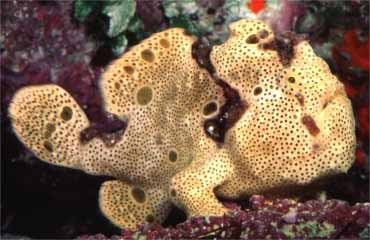

Coral reefs consist of many diverse species of corals. These corals in turn are made up of tiny organisms called polyps. The structure of the polyps and the skeleton of the coral is a rather simple combination. A polyp is made up or two cell layers: the epidermis and the gastrodermis. The non-tissue layer between the gastrodermis and the epidermis is called the mesoglea.
The polyp contains mesentery filaments, which contain nematocysts used in food capture, a pharynx, endothecal dissepiments (horizontal layers of skeletal material) and the columella (the central axis of the corallite found below the mouth). The corallite is the part of the skeleton deposited by one polyp. The skeletal wall around each polyp is called the theca. Other structures include the calice (the upper opening of the corallite), the coenosarc (the coral tissue that stretches over the surface of the coral between the polyps), the coenosteum (the skeletal material around the corallites), and the corallum, which is the skeleton of the coral. The coral anatomy also includes calcareous plate-like structure known as septa. The septa radiate from the wall to the center of the corallite. There are two types of septa: insert septa which lie below the corallite wall and exsert septa which protrude above the corallite wall. We can find the coral reefs trought the world in a range 20 degrees N and 20 degrees S of the equator.
Corals are of two types: perforate and imperforate. Perforate corals have porous skeletons with connections between the polyps through the skeleton. Imperforate corals have solid skeletons. The coral reef as one the most diverse ecosystems on our planet, here is a scientific classification.
Many corals have different growth forms. They can be plocoid as in Tubastrea coccinea (orange cup coral) and Favia fragum (golf ball coral). They can also be meandroid in which corallites form a series within the same walls, as in the species Dendrogyra cylindrus (pillar coral). Other growth forms include cocoid, spherical shaped and phalecoid, as in Eusmilia fastigiata.
There are three basic kinds of coral reefs in the Caribbean: fringing reefs, barrier reefs and atolls. Fringing reefs are coral reefs that grow in shallow waters and border the coast closely or are separated from it by a narrow stretch of water. Fringing reefs consist of several zones that are characterized by their depth, the structure of the reef, and its plant and animal communities. These regions include the reef crest (the part of the reef the waves break over), the fore reef (the region of medium energy), and the spur and groove or buttress zone (the region of coral growth which includes rows of corals with sandy canyons or passages between each row).
Barrier reefs are reefs that are separated from land by a lagoon. These reefs grow parallel to the coast and are large and continuous. Barrier reefs also include regions of coral formation that include the zones found in fringing reefs along with patch reefs (small reefs), back reefs (the shoreward side of the reef), as well as bank reefs (reefs that occur on deep bottom irregularities). Coral reefs also include reef flats (the are of the reef not exposed), the reef crest, which runs parallel to the coast and is protected from waves, and a coral terrace (a slope of sand with isolated coral peaks). These features are followed by another coral terrace and a vertical drop into deeper waters.
The third type of coral reefs are atolls. Atolls are annular reefs that develop at or near the surface of the sea when islands that are surrounded by reefs subside. Atolls separate a central lagoon and are circular or sub-circular. There are two types of atolls: deep sea atolls that rise from deep sea and those found on the continental shelf. A different grapich explanationsabout types of coral reefs.